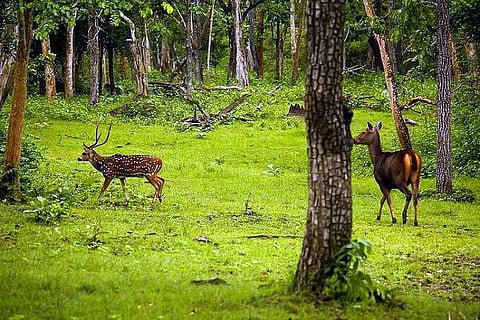

After coming second in the last survey, Karnataka has this topped all other Indian states in generating forest cover in 2019 as per the India State of Forest Report 2019 report. The biennial report is based on Resourcesat-2 LISS III satellite data between November 2017 and March 2018.
According to the report, Karnataka's forest cover has increased more than 1,000, sq km in two years since the last survey was done. Other states which increased their forest cover were Andhra Pradesh and Kerala with 990 sq km and 823 sq km respectively. When it came to trees other than those included in the forest cover, Karnataka stood third highest among states, preceded by Maharashtra and Odisha.
In total, India’s forest cover has increased by 3976 sq km, according to the report, and with this, 21.67% of India’s land is now covered by forests. In 1952, when the first such survey was conducted, the goal was to achieve 33% of forest land.
Released on Monday by the Ministry of Forests, Environment and Climate Change on Monday, the report seems to paint a rosy picture. However, activists and Karnataka Forest Department insiders have raised some questions.
Questions
While, environmentalists based in Karnataka say the state Forest Department has done a good job compared to other states in carrying out plantation activities, the increase in forest cover as per the report figures are too good to be true.
A senior IFS officer in Karnataka, who has worked for more than two decades in the department also found the report “misleading”.
Speaking on condition of anonymity, he said, “Earlier there was around 19% forest cover and now it is 21%. And this 2% increase of 1,000 sq km in two years. This is not possible as even the trees have been planted in two years would not give any density of canopy, which is detected by the satellite. Even if we have 1,000 sq km of area, where we planted the saplings in the two years, it will still remain as saplings.”
He added, “Moreover, much of our forest area is encroached. So are they also included as forest land? This is not clear. Additionally, land has been given away in the guise of Forest Rights Act in Shivamogga, and Chikkamagaluru districts. Even if that land had forest with high density, they were chopped off for food crops being sown immediately. So how can these be counted as forest land?”
He also said that despite directions from Supreme Court, the Forest Department has not been able to recover all the encroached forest land. He questioned if all this land has also been considered as forest land.
He further added, "I feel the increase in forest cover is to do more in terms of forestry in farm lands. So thanks to the department as well as farmers who has really put the tree cover map shoot up. So the tree cover has increased in farm forestry sector in private land holdings given much demand in terms of farm forestry rather than actual tree cover in statutorily declared forests and which is directly under the control of forest department."
“It takes a good two decades’ time for a sapling to be any good as a full grown tree. Moreover there have been instances of tree felling, and loss of habitat due to landslides and floods so how will the real forest grow any larger? The figures are suspect as they might have included even farmlands with some dense growth as forest,” said Joseph Hoover, a former member of the State Wildlife Board and a conservationist.
Why the numbers showed an increase
Top Forest Department officials however, justified this increase in forest cover being reflected in the numbers. Speaking to TNM, Head of Forest Department, Karnataka Punnati Sridhar said a combination of factors have led to the increase in green cover.
“There have been stringent measures for the protection of forest land and community engagement which have led to protection of forests. Moreover, providing cooking gas to communities living around forest areas has meant they have stopped cutting trees. We have departmental planting and also plantation by farmers,” he said.
He added, “This year alone, three crore trees have been planted by the department alone, and another three crore seedlings have been given to farmers at subsidised rates under the Krushi Aranya Prothsaha Yojane.”
However, Joseph Hoover counters that the saplings planted in the last two years don’t really help “unless there is biodiversity, or carbon sequestering potential.” “It is of very little use to us otherwise. And these saplings will also not be picked up in satellite imagery. So I don’t know how this [increase in forest cover] has been recorded.”